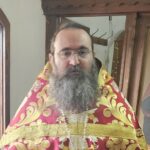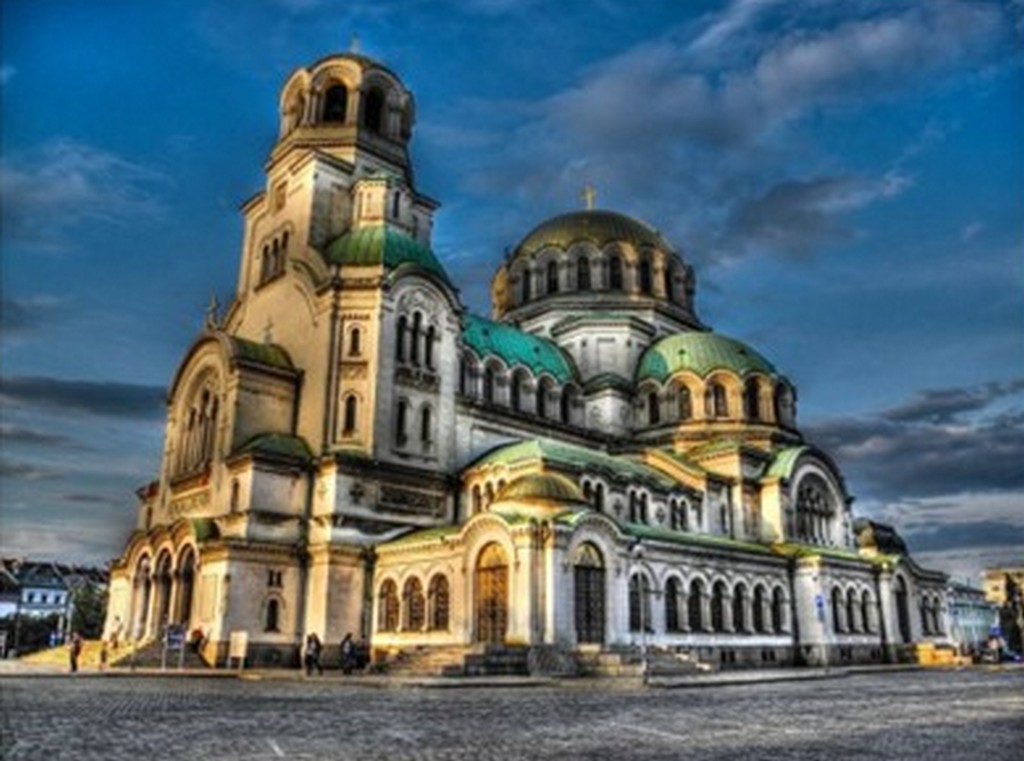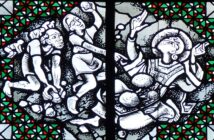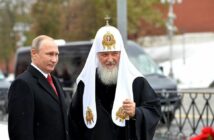Source: Public Orthodoxy
Archimandrite Nicanor (Mishcoff)
Abbot of Tsarnogorsky Monastery “Holy Wonderworkers Kosma and Damian”
It is said that after the Soviet army occupied Bulgaria, Winston Churchill wrote on a napkin in Yalta, “Bulgaria – 25%,” representing the portion of influence the Western allies should have in the new, post-war Bulgaria. Of course, that turned out to be wishful thinking. In two years’ time, the last opposition politician was hanged, and the Soviet influence in the country was so comprehensive that it was referred to as the “16th Republic” (of the former USSR).
After the collapse of the communist regimes, Bulgaria switched sides and joined the Western camp, becoming initially a member of NATO and of the EU soon after. Some 25% influence, however, remained for the USSR, nowadays Russia. Among this 25% is the Bulgarian Orthodox Church.
The Bulgarian Church is often called the first-born daughter of the Patriarchate of Constantinople, because the Bulgarians were the first among the Slavic-speaking world to accept Christianity. They got their own autonomous church at the Council of Constantinople in 870, and soon after, in 927, the first of their three patriarchates was officially recognized. That is, 60 years before the baptism of Kievan Rus, Bulgaria had its own patriarch, and 660 years before Moscovite Rus got theirs. However, the relationships between the mother and the daughter were by no means easy, and every time the Bulgarians lost their statehood, the Patriarchate of Constantinople returned the Bulgarian diocese under its rule. That, by the way, is how the Ohrid Archbishopric was born. Accordingly, as soon as the Bulgarians got their own tsar, they immediately reestablished their autocephalous church, and eventually Constantinople recognized it. The last time this drama played out was 150 years ago, although instead of their tsar, the Bulgarians used the authority of the Ottoman sultan to restore their autocephalous church. There was, however, one difference: the Russian Orthodox Church and the powerful Orthodox Empire behind it took part in the game this time.
In contrast to the old medieval times, Bulgarian and Greek clergy alike were contentedly mired in nationalism, and the struggle between them took on an extremely sharp character. Canonically, Constantinople condemned Bulgarians as heretics/ethno-phyletists at a Church Council in 1872, and the blood of priests from both nationalities was abundantly shed. The Russian Church took a dual stance: on the one hand recognizing the condemnation of the Bulgarians as schismatics and avoiding liturgical communion with the self-proclaimed Bulgarian Exarchate; and on the other, accepting Bulgarian clergymen to study in its theological schools, ordaining Bulgarian students, and allowing them to serve in the Russian churches.
In fact, spiritual ties between the Bulgarians and Russia existed long before. At one time, Bulgarian archimandrite Anatoly (Zhungulovsky, 1765-1848)—at first abbot of the Bigorsky Monastery in modern North Macedonia and later abbot of the Zograf Monastery in Athos, which is still inhabited by Bulgarians—acted as a spiritual adviser of the Russian royal family. However, after the schism, these spiritual ties transformed into a spiritual influence on the part of the Russian Church, and they grew stronger over time. One of the evident effects of this influence is the adoption in Bulgaria of Russian liturgical practices, such as Western polyphonic singing, and some others, which upset the traditionally accepted Byzantine liturgical order and contributed to the alienation of Bulgarians from liturgical life. It is also worth mentioning the revocation of the monastic autonomy of the stavropegic monasteries, following the Russian tradition, which subsequently had most unfavorable effects on Bulgarian monasticism as a whole.
Since the schism did not quickly find its remedy, the diplomatic agencies of the Orthodox countries in the capital of Bulgaria were given the opportunity to build their own chapels for the spiritual needs of their personnel. Thus appeared the Greek, the Romanian, and the Russian churches in Sofia. In 1915, diplomatic relations between the Tsardom of Bulgaria and the Russian Empire were severed because the Empire declared war on the Tsardom. And after the collapse of Russia, Bulgaria for many years did not recognize the new state that arose in its place: the USSR. For this reason, the Russian diplomatic church “St. Nicholas” passed under the control of the Bulgarian church, after in the government expelled from the country its head, Archimandrite Nikolay (Drobyazgin), in 1915. After the war, when many Russian emigrants found refuge in Bulgaria, the church was handed over to them, so a parish of the Russian Church Abroad was formed around it, headed by Archbishop Seraphim (Sobolev), famous for his anti-ecumenism and far-right political views. He was canonized in 2016. Regardless of the political turbulence, the relations between the Bulgarian and Russian churches remained more than cordial, as evidenced by the restoration of the name of the Patriarchal Cathedral in Sofia. It was started as “St. Alexander Nevsky,” then in 1916 was renamed to “St. Cyril and Methodius,” but according to the will of the Bulgarian Synod, in the end in 1924, it was sanctified precisely as “St. Alexander Nevsky” in memory of the Russian Emperor Alexander II. In addition, many times Archbishop Seraphim celebrated liturgy together with the Bulgarian hierarchy, which was considered schismatic.
Things changed dramatically after the notable date of September 4, 1943, when, by Stalin’s order, today’s centralized religious organization, known as “Russian Orthodox Church of the Moscow Patriarchate” was founded under the watchful control of the Soviet secret services, exercised by a specialized legal unit headed by the chekist colonel Karpov. The totalitarian state decided that instead of destroying the church, it was for the better to subjugate it and use it for its (initially) foreign policy goals. Thus, after the establishment of the communist regime in Bulgaria, its church, quite naturally predisposed to this, came under the full control of the Moscow Patriarchate.
In 1945, the schism, which, as the Ecumenical Patriarch Benjamin said, had long since turned into a “peism”, was denounced—partly thanks to the pressure by the Russian Church, partly due to a belated realization in Constantinople of the disastrous consequences of the long-standing opposition and estrangement between the mother and her first-born daughter. But it was too late for the restoration of fraternal ties and communication between the Bulgarian and the Greek churches. The iron curtain had already fallen in Europe, and for decades the ties between them would remain impossible.
On the other hand, the relations between the Russian and Bulgarian churches became increasingly close, even intimate. In the spirit of traditional Orthodox caesaropapism, they followed the governments, where the big brother was the USSR, and the little one, the People’s Republic of Bulgaria. The utter subordination of the Bulgarian Orthodox Church to Moscow was expressed even in such minor details as the adoption of the white veil by the head of the Bulgarian church (unknown in the previous period)—not the patriarchal one, but as of an ordinary metropolitan in Russia. And Bulgarian metropolitans began to wear crosses on their hats, just like the Russian archbishops (to distinguish themselves from the “ordinary” bishops). By adopting the Russian ceremonial, Bulgarian Church demonstrated its subordinate position in the new unwritten hierarchy in the Orthodox world, as an ordinary Russian metropoly. Study in Moscow became a must for the promising Bulgarian clergy intended to occupy key management positions in the church administration. The election of metropolitans and patriarchs, apart from the central committee of the ruling Bulgarian Communist Party, had to be coordinated primarily with the Moscow Patriarchate, and the level of this coordination sometimes went down to appointing the protosingels of key Bulgarian dioceses. The local Bulgarian State Security was responsible for all other minor appointments. This is how the clergy lost its moral authority in Bulgarian society. When, in January 2012, a special government committee opened the files of the former communist secret service, it turned out that almost all the members of the Bulgarian Synod had collaborated with it. It was so shocking that the church did not agree on further disclosure at lower levels of its administration.
Institutionally and for visibility, the Russian ambassador’s church in Sofia was raised to the rank of a podvorie—a kind of a “church embassy” with a representative of the Moscow Patriarch residing there. Reciprocally, a podvorie of the Bulgarian Church was established in Moscow, where “prospective” Bulgarian clergymen used to be sent for in-close observation by KGB. However, not all of them turned out to be “suitable,” and while some subsequently became patriarchs and metropolitans, as late blessed patriarch Maxim (Minkov) or memorable metropolitan Dometian (Topuzliev), others remained in the “preparatory” rank of an archimandrite until the end of their lives. Of the latter, the archimandrites Methodius (Zherev) and Teofan (Dinovsky) should be mentioned. One detail is worth noting here, to which we will return later. After the unilateral proclamation of the Bulgarian Church as a Patriarchate in 1953, the question of the glorification of the relics of the last medieval Bulgarian patriarch Euthymius (+1404) was put forward. These were discovered in 1905 in the Bachkovo Monastery. However, the Moscow Patriarchate strongly opposed this initiative: Bulgarians should know their place and not get proud of some glorious past. It is said that the resolution on the relevant report went as “We do not need that!” (“Нам етого не надо!“)
The changes in 1989 caught the clergy unprepared, and as one of the bishops wrote to his secret service curators, Comrades, what has happened in our country pleases me, and at the same time puzzles me…what position should we take?” For reasons that history has yet to make clear, the instructions of the “comrades” were to organize a schism in 1992 and the Bulgarian Orthodox Church be divided into “red” and “blue” parts, supported by the pro-communist and anti-communist political forces. The so-called “red Synod” continued to be closely related to the Moscow Patriarchate, and the so-called “Alternative Synod” to the Ukrainian schismatics of Filaret Denysenko, who also went into schism in 1992. Both Filaret himself (agent “Antonov”) and the alternative Bulgarian patriarch Pimen (agent “Pirin”) used to be collaborators the communist secret service. However, the schism in the Bulgarian church turned out to be so severe and catastrophic, that in 1998 the daughter remembered that she had a mother and asked the Ecumenical Patriarch to organize a Pan-Orthodox Council in Sofia to resolve the dispute. Under the presidency of Patriarch Bartholomew, the Council affirmed the legitimacy of the current Bulgarian Patriarch, while at the same time forgiving and accepting into communion schismatic hierarchy in the same rank. Later on, the most stubborn of the schismatics, disagreeing with the decisions of the Pan-Orthodox Council, were dealt with using the police force, according to the good old Orthodox tradition. However, in spite of the priceless favor done to it by the Ecumenical Patriarch, the Bulgarian church still remained affiliated with Moscow.
Life might have gone on quietly in the spirit of the old “fraternal friendship” if not for two significant events in Russia: the usurpation of power by Putin and the election of Metropolitan Kirill as the Patriarch of Moscow. With time, everything in Russia returned to its “right” place: the West once more became enemy number one, and the Russian Church, a state department, responsible for the right ideology (replacing the Communist party). This new development was felt back in Bulgaria, where a church scandal broke around the podvorie. In 2013, the Department of Foreign relations of the Moscow Patriarchy got the task to turn the Russian Church (again?) into a church embassy or agency, removing Bulgarian priests serving there, along with their Bulgarian parishioners. The Bulgarian authorities initially reacted to the scandal in a manner well-known from history: they expelled the newly-appointed representative of the Moscow Patriarch in Sofia. However, subsequently, and not without some political pressure from the Russian government, the Bulgarians allowed the Russian priest to come back, and eventually the action turned out to be successful. The culmination of this consecutive Russian-Bulgarian church rapprochement was in 2016, when the two churches jointly canonized Seraphim Sobolev, a conservative Orthodox theologian revered as a miracle-worker by the residents of the Bulgarian capital.
The apogee, however, was the sudden and unmotivated last-minute refusal of the Bulgarian Orthodox Church to participate in the Pan-Orthodox Council in Crete, which gave the Russian Church itself (along with two of its satellites) a convenient excuse to decline the event and thus strike a serious blow to the authority of the Council and the Ecumenical Patriarch himself. Zealot circles in the Bulgarian Church, like their Russian counterparts becoming increasingly stronger, rejoiced greatly. But on a Pan-Orthodox level, the authority of the Bulgarian Orthodox Church collapsed.
Yet, as soon as 2017, the historic friendship between the Russian and Bulgarian churches began to crack due to disagreements over the autocephaly of the Orthodox Church in North Macedonia. In the context of the recently signed friendship treaty between the two neighboring Balkan countries, the Synod in Skopje addressed the Bulgarian Church with a special request: that Bulgarians recognize the autocephaly of the Church in North Macedonia, which, in turn, would recognize the Bulgarian Church as its mother church. This proposal had some historical basis, as the last patriarch of the First Bulgarian Empire resided in Skopje and later in Ohrid, two cities in modern North Macedonia. Subsequently, the Archbishopric, established by Emperor Basil II in 1020 in Ohrid, was known as “Bulgarian” until the very end of its existence in 1767. The re-established in 1870 Bulgarian autocephalous church, under the name of Bulgarian Exarchate, included the entire territory of today’s North Macedonia. The Bulgarian Church administered these lands from 1870 to 1913, as well as in the periods 1915-1918 and 1941-1944. Respectively, the founders of the new church of North Macedonia in 1957 came from among the Exarchate clergy. However, these historical facts have no canonical significance. The Bulgarian Church could not canonically satisfy the request of the Synod in Skopje, and she turned to the other local churches, and first of all to the Ecumenical Patriarchate, which, according to tradition, has the right to establish autocephalous churches.
Note that this process started a year before the Ukrainian church question was officially raised! The Bulgarian government covertly exerted pressure on the Bulgarian Church to ease the solution to the North Macedonian church question. However, the Russian Church stood against this because it had its own plans for North Macedonia. Once again, Russia chose to support its loyal ally Serbia to the detriment of Bulgarian interests. The Russian Church representative in Sofia, Archimadrite Philip Vasiltsev, was reproached for failing to counteract these Bulgarian initiatives. He was dismissed from his position and sent to “exile” in Beirut, and a trusted person of Patriarch Kirill took his place in the capital of Bulgaria. The Russian patriarch arrived in Bulgaria himself in early 2018 to scold the Bulgarian bishops, and alongside them, the Bulgarian president. This turned into a political scandal, as one of the leaders of the ruling coalition at that time publicly rebuked him as a “KGB agent” and a “tobacco metropolitan,” alluding to the shady business of the patriarch back in the 1990s.
Such a clumsy approach by the head of the Russian Church greatly irritated the Bulgarian metropolitans, and two groups began to form in the Bulgarian Synod: russophiles and patriots. The granting of autocephaly to the Ukrainian Church by the Ecumenical Patriarch in 2019 led to further deepening of this division, which gradually spread downwards to the common clergy and the laypeople. For the first time in 150 years, a wing was forming in the Bulgarian church that could be called pro-Phanariotic, despite the fact that the Phanariots were traditionally considered among the biggest enemies of the Bulgarian people. Numerous priests and theologians began to publicly point out the errors of the new Russian ecclesiology and the wrong practices of the Russian Church, such as the humiliation of the priests, the lack of a free theological discussions, the isolation of the bishops from the “laos,” etc. They emphasized the unity and oneness of the Universal Church and the special role that the Ecumenical Councils, through their canonical regulations, had assigned to the Patriarch of Constantinople within it. Thus, although the Bulgarian Synod has not yet recognized the new Ukrainian Church, it rebuffed the numerous Moscow initiatives directed against the Ecumenical Patriarchate, with which—as well as with all other local churches that have recognized the OCU—the Bulgarian Orthodox Church maintains full eucharistic communion. Many bishops and priests who receive and celebrate the liturgy together with OCU clerics at home often visit and co-celebrate the liturgy with Bulgarian clergy. It is perceived that the recognition of the new Ukrainian church by the Bulgarians is not a question of “if” but of “when.”
After the beginning of the full-scale Russian invasion in Ukraine, the process of emancipation of the Bulgarian Church from Moscow intensified, as in their official addresses both the Bulgarian Patriarch and some of the most authoritative Bulgarian metropolitans unequivocally condemned the war and expressed solidarity with the Ukrainian people. Of course, this process is not smooth, since, as mentioned, in the Bulgarian Synod, as well as among the clergy and among the faithful, there is a strong pro-Moscow lobby. A definite success for both the new Russian representative in Sofia and the new chairman of the OVCS was the decision of the Bulgarian Church to recognize the tomos issued by the Serbian Patriarchate for the autocephaly of Skopje. The Bulgarian patriarch began to announce the name of the head of the church in North Macedonia, Archbishop Stefan, as “North Macedonian.” At the same time, the Bulgarian Church is one of the few local churches that responded with sympathy to the letter of the Patriarchate of Alexandria and forbade its clergy to co-celebrate the liturgy with Leonid (Gorbachev), the former Metropolitan of Klin, deposed by the Synod of the Patriarchate of Alexandria.
The most emblematic event, pointing to the new course of Bulgarian Church, however, is its refusal to express any solidarity with the recently expelled representative of the Moscow Patriarch in Sofia, Archimandrite Vassian (Zmeev), accused of espionage by Bulgarian authorities. This not particularly noticeable, quiet, modest, and polite clergyman carefully and accurately performed his tasks as an employee of the OVCS both in Bulgaria and in the neighboring Republic of North Macedonia. There, after on May 9, 2022, the Ecumenical Patriarch accepted the local church into canonical communion, and shortly afterwards the Serbian Patriarchate “honored” it with a “tomos of autocephaly,” and a canonical vacuum arose. After 55 years of schism, its clergy can now co-celebrate with the rest of the Orthodox clergy from all over the world. At the same time, without having received a canonical tomos from the Ecumenical Patriarch, the Church of North Macedonia is still not recognized as autocephalous by many other local churches and practically has no opportunity to participate in Inter-Orthodox and Pan-Orthodox forums, being considered simply a Serbian metropolia. However, this state of affairs satisfies some of its bishops, namely the pro-Serbian and pro-Russian ones. They are actively fighting against the Ecumenical Patriarch’s issuance of tomos of autocephaly, being satisfied with the new form of “autocephaly” invented in Moscow and implemented by the Serbian Synod, in which the “Serbian holy places” in North Macedonia are ceded to be “used” by the North Macedonian Church, while at the same time the metropolies in North Macedonia continue to appear in the Statute of the Serbian Orthodox Church as an integral part of its diocese, as well as the “Orthodox Ohrid Archdiocese” of the Serbian Orthodox Church, whose clergy were “set free” to pass under the jurisdiction of the Skopje Synod, but OOA itself, as an ecclesiastical unit, continues to exist. It is something very similar to the “practical autocephaly” of the Ukrainian Orthodox Church, where its head continues to appear as a permanent member of the Moscow Synod, and its metropolies are considered an integral part of the administrative structure of the Russian Church.
Well, this approach was seen by the authorities in North Macedonia as highly unsatisfactory and harmful to the national identity, so they reacted sharply and on September 15th expelled Archimandrite Vassian from their country, thus showing strong dissatisfaction with the Russian Church’s policy. Archimandrite Vassian was accused of working against the national security of North Macedonia. It is remarkable that in the Bulgarian media this important fact was ignored, and they announced only the expulsion of three civilian employees from the Russian embassy in Skopje. The information about the extreme measures taken against archimandrite Vassian was first revealed on the church news portal hristianstvo.bg (on its page there is a photo of the Ecumenical Patriarch with a blessing for the staff). From there it spread among other media and was spotted by one of the leaders of the coalition of pro-European parties currently ruling in Sofia, who raised the issue before the public and the state institutions. The reaction was immediate, and after a couple of days, most unexpectedly for everyone, Archimandrite Vassian and his two assistants were accused in espionage by the Bulgarian authorities and expelled from the country within hours.
This might have gone unnoticed by the general public if the Russian Embassy in Sofia had not made the odd decision to lock the doors of the Russian Church in Sofia. There, as we mentioned, rest the relics of Archbishop Seraphim, revered as a miracle-worker. If the aim of the embassy had been to make noise, Russian diplomats really succeeded. The scandal turned out to be a spectacular one, and lasted well over three days, acquiring also a political character. Supporters of the Russian Church among the zealot circles, well-known for their ardent anti-ecumenist, anti-West, anti-European, anti-vaccination, and anti-Ukrainian propaganda, organized protests in front of the locked church, accusing Bulgarian authorities of religious persecution and sacrilege. Numerous pro-Putinist organizations and parties joined them, trying to reap political dividends. Bulgarian authorities answered by starting an investigation into the way in which the Russian embassy acquired ownership of the church, not earlier than 1997.
So, what was the reaction of the Bulgarian Orthodox Church to all that? None. No solidarity with the expelled Russian priests, no words of support for the Russian podvorie. In essence, the Bulgarian Church took the side of the Bulgarian state. Moreover, within a few days, the Bulgarian Patriarch, in his capacity as Metropolitan of Sofia, appointed four priests to resume services in the closed church and requested from the Russian Embassy that the church be opened immediately. This way he backed the Bulgarian authorities, removing away from them the accusations about the closing of the church and re-directing the discontent back to the Russian embassy. A patriot of his country, nothing else to say. A week later, the Bulgarian Synod supported the patriarch’s actions. Even the metropolitans from the Russian lobby voted in his support, with the notable exception of the most ardent supporter of Russian church policy, the metropolitan of Vidin, idolized by the above-mentioned zealot circles. The moment was extremely tense, and the Bulgarian state was ready to take over the church and hand it over to the Bulgarian priests, if the Synod had asked for it. The bishops, however, did not wish to deepen the confrontation with the Russians, and yet at the same Synodical meeting, they made the remarkable decision to glorify the relics of St. Euthymius—the same initiative that the Russian Church had once banned, back in the 1950s. The Synod established a special holiday in the calendar of the Bulgarian Church, which will be celebrated every year on October 22 on this occasion.
Despite the strong pro-Moscow lobby, especially among the faithful who were subjected to anti-Western and anti-Phanar propaganda for decades, the Bulgarian Church has no choice but to follow the general policy of the Bulgarian state, which since 2019 pays the salaries of all its clergy. The anti-European rhetoric of the Bulgarian admirers of the “Russian world” collides with the reality of several hundred churches and monasteries, renovated from the ground with European subsidies in the last twelve years. The program for the repairs and restoration of Orthodox churches continues. The Bulgarian Church, moreover, cannot in any way allow itself to enter a confrontation with the Ecumenical Patriarchate, in whose diocese lay significant holy places for Bulgarian national and cultural identity, such as the numerous churches in Istanbul and Edirne, the Zograf Monastery on Mount Athos, etc. Their protection and the preservation of their Bulgarian character will most likely become a subject of negotiations with the Ecumenical Patriarchate. The latter is expected to require the Bulgarian Synod not only to recognize and enter into liturgical communion with the Orthodox Church of Ukraine, but also to adopt the decisions of the Pan-Orthodox Council of Crete.
The Bulgarians have one more reason to comply with the Ecumenical Patriarch, and that is the way the Church of North Macedonia will be named in the tomos of autocephaly to be issued by Phanar. The Bulgarian Orthodox Church considers itself “the heir” of the Ohrid Archdiocese and will look for a way to prevent this name from being exclusively assigned to the church in North Macedonia. What could Moscow offer against all these benefits that the Bulgarians would get through maintaining friendly relations with the Ecumenical Patriarchate? Nothing.
The moment is such that even the re-opening of the Russian podvorie is problematic, because on the one hand, Bulgarian authorities may not give a working visa to the newly appointed representative of the Moscow Patriarch, and on the other, it has become clear to everyone that the Russian Church has been functioning in violation of the Bulgarian Law on Religions, according to which only registered religious entities have the right to perform public religious services, such as the liturgy.
At this stage, the patriots in the Bulgarian Synod and their allies have the decisive word, and the pro-Russian lobby is in retreat. Moscow has nothing to offer the Bulgarian Church to make it continue following her policies. The only thing that the Russian Church’s “diplomats” can do is to offer something specific to specific metropolitans. However, this is by no means safe and may end up with the intervention of the security services and the prosecution.
It looks like the Bulgarian Church will increasingly demonstrate to the Russian Church that it is not her younger brother, but rather her older sister, the first-born daughter of their common mother.
ABOUT AUTHOR
 Archimandrite Nicanor (Mishcoff)
Archimandrite Nicanor (Mishcoff)
Abbot of Tsarnogorsky Monastery “Holy Wonderworkers Kosma and Damian”




